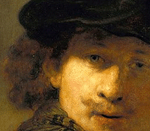
"Parable of the Workers in the Vineyard"
Ferdinand Bol (24 June 1616 - 24 August 1680) was a Dutch painter, etcher and draftsman. Although his surviving work is rare, it displays Rembrandt's influence; like his master, Bol favored historical subjects, portraits, numerous self-portraits, and single figures in exotic finery.
By 1655 Bol was a popular and successful painter. His palette had lightened, his figures possessed greater elegance, and by the middle of the decade he was receiving more official commissions than any other artist in Amsterdam.
Ferdinand Bol made this painting, "Parable of the Workers in the Vineyard", using oil on canvas. The piece is a powerful use of conventional materials to explore unconventional ideas of labor and social context. The thick application of oil paint creates a play of light and shadow, drawing us into the scene. Bol used chiaroscuro to highlight the dignity and humanity of labor, emphasizing the figures' expressions and gestures. Bol masterfully renders the textures of clothing, skin, and the writing materials, reminding us of the handwork involved in both artistic creation and physical labor. This painting reflects a changing social landscape where labor and compensation were hot topics. It prompts questions about the value of work, fair wages, and societal hierarchies. By focusing on the material and the act of making, Bol elevates the status of ordinary workers, challenging traditional distinctions between fine art and craft.